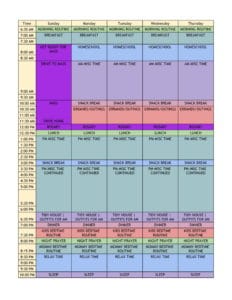You need a simple helpful family schedule if you feel like you are constantly drowning in to-do lists and ever failing schedules! Try block scheduling to help reduce stress for you and your family! We went from micromanaging our schedule down to 15-minute intervals to focusing on blocks of time instead. It reduces anxiety because you know when everything should/could be done even if it is not that day.
For example, I would get overwhelmed with bills that came in that were not on autopay. I would feel that I needed to pay them immediately or I would put them off until it was sometimes late! With block scheduling, you know there is a set time for bill pay and it can wait until its block comes up. Alternatively, if I am home late from work, my whole schedule is not ruined!

1. What is a block schedule?
Block scheduling divides the day into chunks of time that you have to get certain things done such as morning routine block, AM block, PM block, evening block, and night block. Below I have included an example of my block schedule. I have a detailed digital schedule with all possible todos and then a printable version for week to week. I have 2 versions, one for my work week and another for my off week. You can make a schedule for each family member!
2. Why you should use a block schedule?
Block schedules help reduce stress by allowing you to focus more on one activity or another in a certain time slot without getting behind on a schedule. If your AM block involves errands – sometimes it can be a doctor’s appointment and a trip to the post office and at other times it can be a run to Costco and the Dollar Tree. If your evening block includes dinner and chores, some nights you can have a longer dinner and some nights you might choose to have a shorter dinner time so you can get some chores done before bed.

3. How to get started with Family Schedule Blocks
You literally assign all of your routine tasks to different time slots. In this way, you know what to do when and you know that important things will be addressed if you follow the schedule. Examples include husband quality time/date night, chores, bills, meal prep, prayer time, self-care time, etc. Make a list of all the things you routinely do and assign them to a block.
Within each block will be things that need to be done each time the block comes up and some extras. My PM block includes chores which must occur during that time slot but it does not have to be the same chore each day. Make all of your appointments and errands for the same time slot so you are leaving the house at specific times instead of random times. This helps you stick to a routine in that, for example, you always will schedule outings for the morning so that you can be home and cleaning during nap time or, if you work, scheduling outings for immediately after work during a set time before dinner.

4. Prioritization of To-dos
-
- Parkinson’s Law states that your work will expand to fill the allotted time. We all know the difference between an all-nighter paper vs a paper you worked on for over 2 weeks which can sometimes still turn into an all-nighter.
- Set timers and stick to the allotted blocks!
- Overestimate the amount of time it will take you to complete tasks so you are not running over into the next block.
- List your top 3 priorities for the next day each evening. Usually, these are the things that you don’t want to do–pay bills, make that dreaded phone call, etc.
- Make time to plan your schedule for the upcoming week/day.
- Include time for breaks and self-care time.
- Block schedules can easily be tweaks as needed.
- Do not do anything else for example, cell phone, emails, social media, during block if not scheduled.
5. Emergency Schedule Blocks
Block scheduling allows for emergency mode as well. If illness, accidents, house repairs, etc., come up, then you can stick to essential blocks only. Have an emergency block schedule made ahead of time to be prepared for what really needs to get done in the event of something time-consuming happening. You can catch up on the missed blocks on the next cycle or the next day- however you can fit it in!

6. Mother’s Rule Family Schedule
Prioritize your schedule based on your needs and wants. If you have not read A Mother’s Rule of Life, it contains helpful information on prioritizing your schedule. There is a lot of extra information in the book, but the chapters on designing a schedule are informative. It uses the five Ps (Prayer, Person, Partner, Parent, Provider) to differentiate needs. First is God, second is your basic needs, then your husband’s needs, next your children’s needs, and lastly the income and household needs.
It incorporates specific chores before and after meals. Each family member is assigned specific chores and knows their role. In each meal block, basic chores are addressed so that at the end of the day there is not a massive mess. The children know what to expect next in the schedule and it helps reduce their stress levels too!

7. Family Block Schedule Template
There is no specific template for a family schedule as each schedule will differ based on work, school, and needs. Your schedule will change overtime as your children are able to take on more and different responsibilities. Due to the nature of the block schedule it is easy to make tweaks. I have created an editable version in Google docs- simply click the link then go to file and make a copy. Save this file and edit away! Or you can download and print this pdf to make your block schedule. My planner also includes sections for your block schedule!
Start your new year off right and create your simplified family schedule! Let me know your family schedule tips in the comments below.



